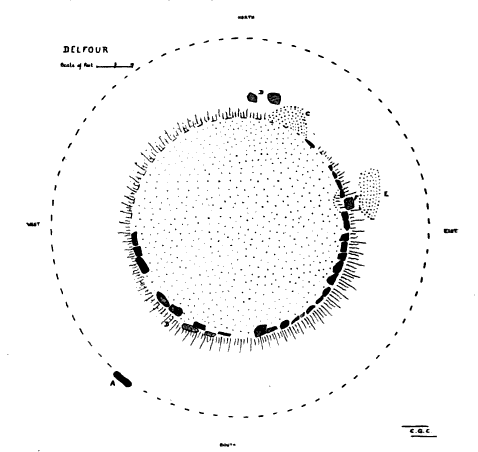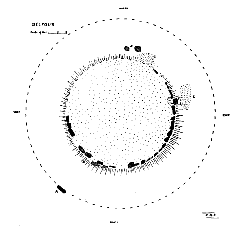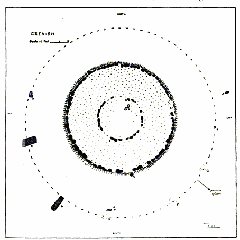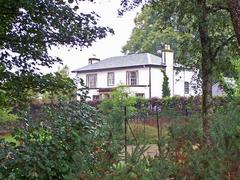
Clava Cairns Visiting Hours, Tickets, and Comprehensive Guide to Inverness Historical Sites
Date: 14/06/2025
Introduction to Clava Cairns: A Window into Bronze Age Scotland
Situated a few miles east of Inverness in the Scottish Highlands, the Clava Cairns are among Scotland’s most remarkable prehistoric monuments. Dating back nearly 4,000 years, this ancient cemetery complex features an array of beautifully preserved burial cairns and stone circles. These structures stand as enduring testaments to the ingenuity, spirituality, and astronomical awareness of Bronze Age communities. Visitors to Clava Cairns are treated to both a tranquil woodland setting and an exceptionally well-preserved archaeological landscape, making the site a must-visit for history enthusiasts, archaeology buffs, and curious travelers alike (Historic Environment Scotland; World History Encyclopedia).
This comprehensive guide covers everything needed for a visit: opening hours, ticket information, accessibility, travel suggestions, and key highlights of the site’s cultural and astronomical significance. It also provides recommendations for combining your visit with other notable Inverness historical sites.
Visiting Clava Cairns: Essential Practical Information
Visiting Hours
Clava Cairns is generally open year-round from dawn to dusk. There are no gates or fences, so you may visit at any time, though daylight hours are recommended for safety and the best views. For the most current information on seasonal access or occasional closures, check the Historic Environment Scotland official page.
Tickets and Entry Fees
Admission to Clava Cairns is free and does not require a ticket. There are no on-site staff or ticket booths; visitors are welcome to explore the site at their own pace.
Accessibility
The cairns are set within a woodland area with mostly flat but uneven paths. Surfaces can be grassy, muddy, or gravelly, especially after rain. Visitors with limited mobility or wheelchair users may find some areas challenging, and there are no dedicated accessible facilities. Assistance dogs are welcome.
Facilities
There are no restrooms, visitor centers, or cafés at Clava Cairns. Informational boards are provided to help interpret the site’s history and features. For amenities, plan to stop in Inverness or at nearby attractions.
Travel Tips
- Getting There: Clava Cairns is about 7 miles (11 km) east of Inverness and 1.5 miles (2.4 km) from Culloden Battlefield. The site is best reached by car, with a small free car park available. Taxis from Inverness are a practical alternative; public transport does not serve the site directly.
- Best Time to Visit: Early mornings and late afternoons are quieter and offer the best lighting for photography. The winter solstice is a particularly special time, as the cairns align with the setting sun.
- Duration: Most visitors spend 30–60 minutes at the site.
- Nearby Attractions: Combine your visit with Culloden Battlefield, Cawdor Castle, or Loch Ness for a broader exploration of the Highlands (VisitScotland; Lost in Landmarks).
Photography and Site Etiquette
Photography is encouraged, especially during sunrise, sunset, and the winter solstice. Please do not climb on the cairns or standing stones, and remain on marked paths to protect this sensitive archaeological site.
Clava Cairns: Historical and Cultural Background
Origins and Construction
Clava Cairns was established around 2000 BCE and is the “type site” for a distinctive group of prehistoric monuments found mainly in the Central Highlands—over 50 similar cairns exist in the Moray Firth region (Wikipedia; Historic Environment Scotland Portal). Each cairn consists of a stone mound surrounded by a ring of graded standing stones. Two main types are present: passage graves (with stone-roofed burial chambers) and ring cairns (with open central spaces). Both demonstrate advanced construction techniques and a sophisticated understanding of astronomical alignments (NOSAS Archaeology Blog).
Archaeological Investigations
Excavations from the 19th century onward have revealed both inhumation and cremation burials, suggesting the cairns served as important ritual sites for centuries (World History Encyclopedia; Discover Highlands and Islands). The presence of later burials, including Pictish cremations, demonstrates the site’s enduring significance.
Astronomical Alignments
The passage graves are oriented toward the southwest, precisely in line with the setting sun at the winter solstice. This alignment reflects a deep awareness of celestial cycles and may have played a role in seasonal rituals (Academia.edu; Scotland’s Wild). Some cairns also exhibit lunar alignments with the midsummer full moon and the 18.6-year lunar cycle, indicating a complex cosmological symbolism (Culture and Cosmos).
Symbolism and Ritual
The cairns’ design—passage graves linked to sunset and darkness, ring cairns associated with sunrise and light—suggests binary themes of life, death, and rebirth. The use of quartz, cup and ring marks, and graded stone circles all reinforce their ceremonial and possibly astronomical functions (SCARF).
Exploring Clava Cairns: Site Layout and Features
Main Site: Balnuaran of Clava
The primary complex consists of three main cairns, arranged northeast to southwest:
- North Cairn: Passage grave, with a stone-built corridor leading to a central, originally roofed chamber.
- Mid Cairn (Central Cairn): Ring cairn, lacking a passage, likely used for open-air rituals or cremations (Secret Scotland).
- South Cairn: Passage grave similar to the North Cairn, with a southwest-facing entrance (True Highlands).
Each cairn is surrounded by a circle of standing stones, tallest to the southwest. Many stones are decorated with enigmatic cup marks.
Additional Features
- Kerb Cairns: Smaller mounds dating from later phases of use, about 1,000 years after the main cairns (VisitScotland).
- Milton of Clava: A short walk away, this secondary area includes another cairn, a standing stone, and the remains of a medieval chapel (Lost in Landmarks).
Visitor Experience
Marked woodland paths and informational boards guide visitors around the site. Please stay on paths to preserve the archaeology.
Frequently Asked Questions (FAQ)
Q: What are the Clava Cairns?
A: A prehistoric cemetery complex with Bronze Age burial cairns and stone circles near Inverness.
Q: What are the opening hours?
A: The site is open 24/7, year-round; daylight hours are recommended.
Q: Do I need a ticket or pay an entrance fee?
A: No, entry is free and unticketed.
Q: Can I access the site by public transport?
A: No direct public transport; access is best by car, taxi, or as part of a guided tour.
Q: Are guided tours available?
A: Not on-site, but local operators in Inverness offer tours including Clava Cairns.
Q: Is the site accessible for those with limited mobility?
A: Some areas can be uneven and muddy; wheelchair access is limited.
Q: Are pets allowed?
A: Yes, but keep them on a leash and under control.
Outlander Connection
Though not a filming location, Clava Cairns inspired the fictional Craigh na Dun stone circle in the “Outlander” series, making it a popular stop for fans of Scottish history and folklore.
Nearby Attractions
- Culloden Battlefield: Explore the site of the 1746 battle, just 1.5 miles away.
- Cawdor Castle: A fairy-tale castle with beautiful gardens.
- Loch Ness and Urquhart Castle: Easily combined for a full day of Highland history.
Visuals and Media
For an enhanced experience, browse high-quality images and virtual tours of Clava Cairns on official tourism sites. Use interactive maps to plan your journey and visualize the cairns’ layout and astronomical alignments.
Plan Your Visit and Next Steps
Clava Cairns is a captivating destination offering a unique window into Scotland’s Bronze Age past. With free entry and a peaceful setting, it’s ideal for self-guided exploration or as part of a broader Highlands itinerary. For the latest updates, guided tour options, and event information, check local tourism sites and Historic Environment Scotland.
Download the Audiala app for audio guides, interactive maps, and tips on exploring Inverness historical sites. Follow us on social media for travel inspiration and updates.
Summary
The Clava Cairns encapsulate Scotland’s prehistoric heritage, blending architectural skill, astronomical knowledge, and spiritual significance. Open year-round with free access, the site offers visitors a tranquil and evocative setting to connect with the ancient past. Combine your visit with other iconic Highland sites for a truly enriching experience (Historic Environment Scotland Portal; Culture and Cosmos; VisitScotland; True Highlands).
Sources and Further Reading
- Clava Cairns Visiting Hours, Tickets & Historical Guide to Inverness’s Ancient Monument (Historic Environment Scotland)
- Cultural and Astronomical Significance of Clava Cairns: Visiting Hours, Tickets, and Inverness Historical Sites Guide (Culture and Cosmos)
- Clava Cairns Visitor Guide: Visiting Hours, Tickets, and Historical Insights near Inverness (VisitScotland)
- Clava Cairns Visiting Hours, Tickets, and Visitor Guide to Inverness Historical Sites (Lost in Landmarks)
- The Clava Cairns of Scotland: Midsummer Full Moon and the Major Lunar Limit (Academia.edu)
- SCARF Bronze Age Panel Report: Cosmology and Bronze Age Monuments (SCARF)
- World History Encyclopedia: Clava Cairns (World History Encyclopedia)



